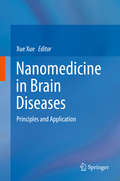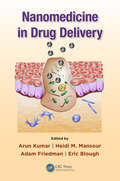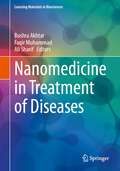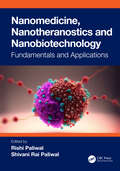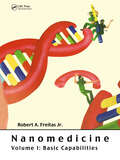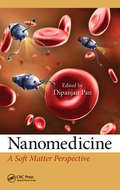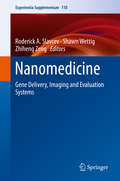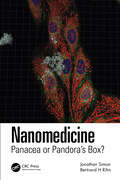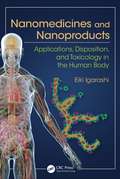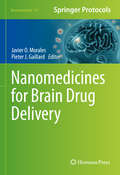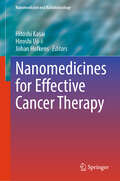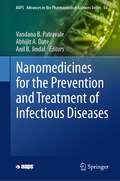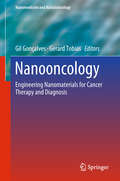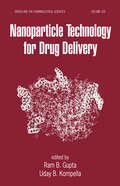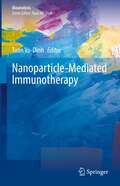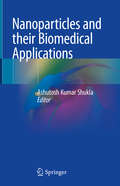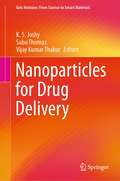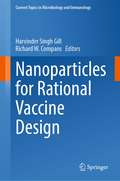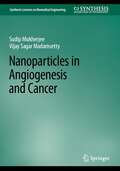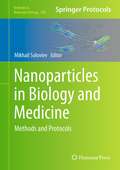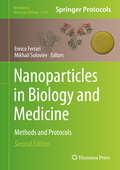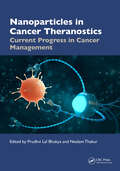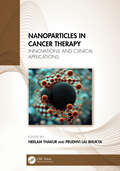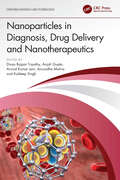- Table View
- List View
Nanomedicine in Brain Diseases: Principles and Application
by Xue XueThis book provides an overview of the current applications of nanomaterials in brain diseases, and introduces several novel nanomaterials that have excellent potential in this field. During the last two decades, nanotechnology had matured significantly as it has transitioned from a bench-top science to an applied technology. However, the application of nanomaterials in basic and clinical neuroscience is still at an early stage, and understanding how the intrinsic properties of nanomaterials translate to complex biological responses is an area of intensive research. Part 1 of the book focuses on the principles and strategies of nanomedicine in the brain diseases, while part 2 examines the applications of promising nanomaterials for therapy and diagnosis in the brain. Together they offer a comprehensive picture of advances in nanotechnology and their successful use in treating brain diseases in the past 20 years.
Nanomedicine in Drug Delivery
by Adam Friedman Heidi M. Mansour Arun Kumar Eric R. BloughThere is a clear need for innovative technologies to improve the delivery of therapeutic and diagnostic agents in the body. Recent breakthroughs in nanomedicine are now making it possible to deliver drugs and therapeutic proteins to local areas of disease or tumors to maximize clinical benefit while limiting unwanted side effects. Nanomedicine in D
Nanomedicine in Treatment of Diseases (Learning Materials in Biosciences)
by Bushra Akhtar Faqir Muhammad Ali SharifNanomedicine biotechnology is applied to and used to study drug development, working mechanisms, diagnosis, and therapies. This textbook particularly written for biomedical applications of nanomedicine covers the whole range of disease treatments related to nanomedicine. This book serves the purpose of highlighting the current advancements of nanomedicines-based regimens which may be employed in disease treatment while it also contains the fundamental knowledge for biomedical researchers from all levels. Each chapter starts with an introduction/theory into the specified approaches for various disease states followed by detailed discussions for a comprehensive understanding. This book best suits advanced level students, but also provides an excellent updated material for researchers and healthcare workers related to nanomedicine and diseases treatment.
Nanomedicine, Nanotheranostics and Nanobiotechnology: Fundamentals and Applications
by Rishi Paliwal Shivani Rai PaliwalNanosized particles explored for therapeutics and diagnosis-related research areas need the latest updated information for budding researchers as well as academicians. Nanomedicine, nanotheranostics, and nanobiotechnology have been contemporary technological tools for diverse biomedical, pharmaceutical, and diagnostic solutions. The present book is divided into two sections.The first section is dedicated to exclusive book chapters related to nanomedicine such as its history, regulatory aspects, scale-up, and regulatory toxicology. Additionally, this section includes chapters focusing on the application domain of nanomedicine for targeted cancer therapy, rheumatoid arthritis management, psoriasis treatment, ocular delivery, topical applications, oral bioavailability enhancement, and pulmonary delivery.The second section is composed of chapters in the area of nanotheranostics and applications of nanobiotechnology. In brief, the latest topics such as gold nanoparticles in diagnostics and therapy, nanoparticles for siRNA delivery, carbon nanotubes for gene delivery, nanoparticles for vaccine delivery, nanobiotechnology in cell-based nanomedicines, nanotechnology in regenerative medicine, and nanocarriers in delivery of proteins and peptides are complied.KEY FEATURES A total of 26 emerging topics are covered in the book on cutting-edge research areas at the multi-disciplinary level. The chapters focus on fundamentals and applications, making the book attractive for beginners as well as experts. The chapters are written by well-known experts of the field in a simple scientific style with figures, schemes, and illustrations.
Nanomedicine, Volume I: Basic Capabilities
by Robert A. FreitasMolecular nanotechnology has been defined as the three-dimensional positional control of molecular structure to create materials and devices to molecular precision. The human body is comprised of molecules, hence the availability of molecular nanotechnology will permit dramatic progress in human medical services. More than just an extension of "molecular medicine," nanomedicine will employ molecular machine systems to address medical problems, and will use molecular knowledge to maintain and improve human health at the molecular scale. Nanomedicine will have extraordinary and far-reaching implications for the medical profession, for the definition of disease, for the diagnosis and treatment of medical conditions including aging, for our very personal relationships with our own bodies and ultimately for the improvement and extension of natural human biological structure and function. This book will be published in three volumes over the course of several years. Readers wishing to keep up-to-date with the latest developments may visit the nanomedicine website maintained by the Foresight Institute (http://foresight.org/Nanomedicine/index.html).
Nanomedicine: A Soft Matter Perspective
by Dipanjan PanThe unprecedented potential of nanotechnology for early detection, diagnosis, and personalized treatment of diseases has found application in every biomedical imaging modality. However, with the increasing concern about the ethical and toxicity issues associated with some "nanoplatforms," biomedical researchers are in pursuit of safer, more precise
Nanomedicine: Gene Delivery, Imaging and Evaluation Systems (Experientia Supplementum #110)
by Roderick A. Slavcev Shawn Wettig Zhiheng ZengThis work was compiled to serve as a convenient source that covers a number of techniques (and details of their use) in the rather large field of nanomedicine, with special attention paid to gene delivery. As principal investigators working in the field of nanomedicine, we sought to put together the most current and relevant topics in gene delivery, imaging and evaluation systems. We expect the work to serve very well for scientists and graduate students in the nanomedicine field.
Nanomedicine: Panacea or Pandora's Box?
by Jonathan Simon Bertrand H. RihnThe book is an introduction to nanomedicine informed by a philosophical reflection about the domain and recent developments. It is an overview of the field, sketching out the main areas of current investment and research. The authors present some case-studies illustrating the different areas of research (nanopharmacy, theranostics and patient monitoring) as well as reflecting on the risks that accompany it, such as unanticipated impacts on human health and environmental toxicity. This introduction to a fast-growing field in modern medical research is of great interest to researchers working in many disciplines as well as the general public. In addition to an overview of the work currently ongoing, the authors critically assess these projects from an ethical and philosophical perspective. Key Features Provides an overview of nanomedicine Employs a reflective and coherent critical evaluation of the benefits and risks of nanomedicine Written in an accessible manner intended for a wide audience Related Titles Hehenberger, M. Nanomedicine: Science, Business, and impact (ISBN 978-9-8146-1376-7). Beg, S., et al. Nanomedicine for the treatment of Disease: From Concept to Application (ISBN 978-1-7746-3443-1) Brenner, S. The Clinical Nanomedicine Handbook (ISBN 978-1-1380-7578-8)
Nanomedicines and Nanoproducts: Applications, Disposition, and Toxicology in the Human Body
by Eiki IgarashiNanomedicines and Nanoproducts: Applications, Disposition, and Toxicology in the Human Body provides a detailed overview of the disposition of nanoproducts within the body, with a special focus on the respiratory and olfactory routes of nanoproduct administration, buccal exposure and the ingestion of nanoproducts, the integumentary system (formed by the skin, hair, nails, and associated glands), the ocular route, the systemic route, and toxicology as it relates to the nanoscale world.Offering an interdisciplinary, big-picture view of the current and future state of nanotechnology, this book: Identifies key points for the entry of nanoproducts, nanomedicines, and other nanoscale structures into the body Reviews the bodily administration and subsequent disposition of nanoproducts via various exposure routes Describes the intravenous route of administration for the therapeutic management of ocular disease Discusses practical nanoproduct and nanomedicine applications, disposition, and toxicology Summarizes various toxicological principles and the testing of nanoproducts Nanomedicines and Nanoproducts: Applications, Disposition, and Toxicology in the Human Body addresses the scope of practical nanoparticle applications in academic research as well as industrial investigation, where "practical" is defined as advantageous in all aspects of nanoproduct disposition, efficacy, and toxicology. The book’s goal is to introduce potentially beneficial applications and exciting topics regarding nanoproducts to a variety of professional and general readers.
Nanomedicines for Brain Drug Delivery (Neuromethods #157)
by Javier O. Morales Pieter J. GaillardThis volume explores the latest research in central nervous system (CNS) targeted nanocarriers, methods for their synthesis, and its characterization process. Chapters in this book cover topics such as polymeric nanoparticles and liposomes; self-assembled peptide-based scaffolds for lesions of the nervous system; use of peptides as CNS drugs and as potential carriers to optimize brain-targeted delivery; ways to model and assess blood brain barrier absorption of drugs; and the role of neurodegeneration progress of nanomaterials and their potential toxicity concerns. In the Neuromethods series style, chapters include the kind of detail and key advice from the specialists needed to get successful results in your laboratory.Thorough and cutting-edge, Nanomedicines for Brain Drug Delivery is a valuable resource that will help researchers guide and advance the field of nanomedicines for the brain and nervous system.
Nanomedicines for Effective Cancer Therapy (Nanomedicine and Nanotoxicology)
by Johan Hofkens Hitoshi Kasai Hiroshi Uji-IThis book describes in detail the most up-to-date designs and fabrication techniques for nanomedicines toward effective cancer therapy, while especially emphasizing the biological interaction of nanomedicines at the cellular level, through comprehensive and visual cutting-edge technologies. Unlike other books on the general subject of medicine or drug delivery, this book provides readers the comprehensive information regarding what happens to the nanomedicine at the cell membrane surface, uptake mechanism, and what biochemical process it undergoes inside the cellular matrix. This full overview of the interaction between nanomedicines and cells also provides insights of how to design nanomedicines for effective cancer therapy.
Nanomedicines for the Prevention and Treatment of Infectious Diseases (AAPS Advances in the Pharmaceutical Sciences Series #56)
by Vandana B. Patravale Anil B. Jindal Abhijit A. DateThe COVID-19 pandemic has altered the world and reiterated the perpetual need for the development of effective strategies for the prevention and treatment of infectious diseases. While globally prevalent infectious diseases receive extensive attention in terms of drug development and delivery, the neglected and/or emerging infectious diseases that affect developing countries are often overlooked. Additionally, the therapeutic efficacy of existing anti-infective agents is often limited due to sub-optimal biopharmaceutical properties, sub-therapeutic levels of the drugs at the infection site due to various physiological barriers, the expulsion of the drug by efflux transporters, and the emergence of drug-resistant strains.From the commercialization of AmBisome® to the emergency authorization of mRNA-based vaccines, nanotechnology has played a vital role in the prevention and treatment of infectious diseases. More importantly, nanotechnology has enabled the effective utilization of existing armamentarium against infectious diseases leading to improved therapeutic outcomes with a concomitant reduction in the side effects associated with anti-infective agents. In particular, nanotechnology can bring about a paradigm shift in the management of neglected and emerging infectious diseases and may compensate for the lack of drug discovery efforts. While there are several books dedicated to pharmaceutical and/or biomedical applications of nanotechnology or nanotechnology for cancer therapy a comprehensive book focusing on the prevention and/or treatment of viral, bacterial, fungal, and parasitic infections is not available. This book addresses an unmet need in pharmaceutical and medical education.This book provides a comprehensive and up-to-date overview of the latest advancements in nanomedicine, which show great potential for preventing and treating infectious diseases. Covering a wide range of topics, it explores various formulation strategies for combating microbial, fungal, parasitic, and viral infections. The book emphasizes the advantages of nano-scale vaccines over traditional ones and discusses their production. It also examines feasible treatment approaches for diseases like malaria, trypanosomiasis, candidiasis, Hepatitis B, HIV, and the ongoing COVID-19 pandemic. Additionally, it highlights the role of nano-adjuvants in vaccine development, as well as the use of peptide antibiotics and pulmonary delivery of drugs, which open up new possibilities in fighting infectious diseases. Furthermore, the book explores the critical role of nanomedicine in addressing veterinary parasitic infections. The emergence of nanotechnology has led to novel strategies for diagnosing, treating, and preventing parasitic infections in animals.In summary, this book offers a comprehensive description of clinically viable and investigational nanotechnology-enabled medicines (nanomedicines) for the prevention and treatment of globally prevalent, neglected, and emerging infectious diseases.
Nanooncology: Engineering nanomaterials for cancer therapy and diagnosis (Nanomedicine and Nanotoxicology)
by Gil Gonçalves Gerard TobiasThis book presents a systematic overview of the most relevant nanomaterials and their respective intrinsic properties that have been highly explored by the scientific community and pharmaceutical companies in several different modalities for cancer therapy and bioimaging. The chapters explore the synergistic effects provided by the different nanostructured materials and highlight the main in vitro and in vivo therapeutic achievements on cancer. This work also provides relevant discussion about the recent progresses and future challenges that nanotechnology faces on the conception of more efficient nanoformulations against primary tumors, circulating cancer cells and metastases.
Nanoparticle Technology for Drug Delivery (Drugs and the Pharmaceutical Sciences)
by Uday B. Kompella Ram B. GuptaNanoparticles, products of nanotechnology, are of increasing interest to the pharmaceutical community. They can increase drug solubility, enhance bioavailability, allow tissue targeting, offer decreased side-effects, and improve therapeutic efficacy. Presenting the most pertinent and practical issues in the manufacturing and biological application
Nanoparticle-Mediated Immunotherapy (Bioanalysis #12)
by Tuan Vo-DinhThis book is intended to serve as an authoritative reference source for a broad audience involved in the research, teaching, learning, and practice of nanotechnology in immunotherapy. The combination of nanotechnology and immunotherapy is recognized as a promising treatment modality. In particular, the use of nanoparticles in immunotherapy has attracted increased attention for their unique efficacy and specificity in cancer treatment. A wide variety of nanoparticles, such as polymeric and liposomal nanosystems, carbon nanotubes, and gold nanoparticles have provided important nanoplatforms for immunotherapeutic approaches. They have been shown to improve delivery and efficacy of immunotherapeutic agents such as vaccines or adjuvants. Nanoparticle-mediated thermal therapy has demonstrated the effectiveness for precise tumor cell ablation, radio-sensitization of hypoxic regions, enhancement of drug delivery, activation of thermosensitive agents, and enhancement of the immune system. Plasmonic nanoparticles are a special type of metallic nanoparticles that has received great interest due to their enhanced optical and electromagnetic properties and their superior capacity to convert photon energy into heat for selective photothermal therapy at the nanoscale level. Nanoparticle sizes can also be controlled such that they accumulate preferentially in tumors due to the enhanced permeability and retention effect of tumor vasculature. Various nanosystems such as gold nanoparticles have also been shown to stimulate the immune system. Immunotherapies could thus synergistically benefit from the combination with targeted nanoparticle-mediated photothermal therapies, especially when hyperthermia around immune-checkpoint inhibitors in the tumor bed is combined with precise thermal ablation of cancer cells. Of great importance is the possibility that such an approach can induce long-term immunological memory that can provide protection against tumor recurrence long after treatment of the initial tumors, like an ‘anticancer vaccine’. Nanoparticle-mediated immunotherapy could lead to an entirely new treatment paradigm that challenges traditional surgical resection approaches for many cancers and metastases.
Nanoparticles Induce Oxidative and Endoplasmic Reticulum Stresses: Antioxidant Therapeutic Defenses (Nanomedicine and Nanotoxicology)
by Loutfy H. MadkourThis book provides insights and tools for better understanding redox biology and medicine and, in the long run, to finding new therapeutic strategies to target dysregulated redox processes in various diseases. It presents the recent advances in new nanomedication technologies of the effects of nanoparticles NPs on oxidative stress, RONS and ER stress. The book comprises 13 chapters covering ecotoxicology, cytotoxicity, nanotoxicity and genotoxicity mechanisms causing by the role and interactions of nanoparticles and free radicals with (RONS) and (ER) stress. Endoplasmic Reticulum (ER) Stress as a mechanism for NPs induced toxicity has been discussed. The advances of nanotechnology and the effects of nanoparticles on oxidative stress, ROS and ER stress parameters are discussed. Antioxidants, therapeutic options and regulation of the immune responses are explained throughout the book.
Nanoparticles and their Biomedical Applications
by Ashutosh Kumar ShuklaNanotechnology is expected to bring revolutionary changes in a variety of fields. This volume describes nanoparticles and their biomedical applications, and covers metal nanoparticles, metal oxide nanoparticles, rare earth based nanoparticles and graphene oxide nanoparticles. It elaborates on a number of biomedical applications, including therapeutic applications. It addresses the topic of green synthesis, in view of increasing health and environmental concerns.
Nanoparticles for Drug Delivery (Gels Horizons: From Science to Smart Materials)
by Sabu Thomas Vijay Kumar Thakur K. S. JoshyThis book introduces the reader to drug delivery with specific emphasis on the use of nanoparticles. It covers properties, characterization, and preparation of different types of nanoparticles and discusses recent advances in their structural design and biomedical application, as well as the issues and challenges associated with their design and use. Some of the topics covered include the potential application of nanoparticles in biomedical fields, hazards associated with use of nanoparticles for drug delivery, size-dependent factors in drug delivery applications, different organic, inorganic and their hybrid systems used in drug delivery, etc. It also highlights use of nanoparticles in controlled and targeted drug delivery, and their application in stimuli-responsive, especially pH-responsive, drug release. Additionally, it also focuses on biomimetic nanoparticles, challenges faced in the designing of nanoparticles for drug delivery in cancer, viral and bacterial diseases. The contents of this volume will be useful to researchers and professionals working on advances in targeted drug delivery systems.
Nanoparticles for Rational Vaccine Design (Current Topics in Microbiology and Immunology #433)
by Richard W. Compans Harvinder Singh GillThis book introduces nanoparticles as a powerful platform for vaccine design. Current challenges in vaccine development are discussed and the unique advantages nanoparticles provide in overcoming these challenges are explored. The authors offer fascinating insights into the immunological assets of using nanoparticles as delivery vehicles or adjuvants and present different materials that are being used in nanoparticle-based vaccine development, covering peptides, proteins, polymers, virus-like particles, and liposomes.Its contemporary research insights and practical examples for applications make this volume an inspiring read for researchers and clinicians in vaccinology and immunology. Chapter "Liposome Formulations as Adjuvants for Vaccines" is available open access under a Creative Commons Attribution 4.0 International License via link.springer.com.
Nanoparticles in Angiogenesis and Cancer (Synthesis Lectures on Biomedical Engineering)
by Sudip Mukherjee Vijay Sagar MadamsettyThis book highlights recent developments of organic and inorganic nanomedicine that play a major role in anti-angiogenic cancer therapy. In addition, the authors present examples of nanomedicine based anti-angiogenic agents and their applications in cancer therapy. Angiogenesis is a pathophysiological phenomenon that modulates cell proliferation and cell migration and plays important roles in cancer. Anti-angiogenic nanotherapies have gained immense attention in recent times as alternative cost-effective therapies that opened a new dimension in cancer theranostics. Further the challenges of the anti-angiogenic nanotherapies and possible future perspective are detailed.
Nanoparticles in Biology and Medicine
by Mikhail SolovievThe modern fascination with micro- and nano-sized materials can actually be traced back further to the 1960s and '70s when the first few reported attempts were made to use nanoparticles for controlled drug delivery. In Nanoparticles in Biology and Medicine: Methods and Protocols, experts in the field present a wide range of methods for synthesis, surface modification, characterization, and application of nano-sized materials (nanoparticles) in life science and medical fields, mostly for drug delivery. The methods presented cover all stages of nanoparticle manufacturing, modification, analysis, and applications. Written in the highly successful Methods in Molecular BiologyTM series format, chapters include introductions to their respective topics, lists of the necessary materials and reagents, step-by-step, readily reproducible laboratory protocols, and tips on troubleshooting and avoiding known pitfalls. Comprehensive and cutting-edge, Nanoparticles in Biology and Medicine: Methods and Protocols will help the beginner become familiar with this fascinating field and will provide scientists at all levels of expertise with easy-to-follow practical advice needed to make, modify, and analyze nanoparticles of their choice and to use them in a wide range of biomedical and pharmaceutical applications, including functional protein studies, drug delivery, immunochemistry, imaging, and many others.
Nanoparticles in Biology and Medicine: Methods And Protocols (Methods In Molecular Biology Ser. #906)
by Mikhail Soloviev Enrico FerrariThis fully updated volume presents a wide range of methods for synthesis, surface modification, characterization and application of nano-sized materials (nanoparticles) in the life science and medical fields, with a focus on drug delivery and diagnostics. Beginning with a section on the synthesis of nanoparticles and their applications, the book continues with detailed chapters on nanoparticle derivatization, bio-interface, and nanotoxicity, as well as nanoparticle characterization and advanced methods development. Written for the highly successful Methods in Molecular Biology series, chapters include introductions to their respective topics, lists of the necessary materials and reagents, step-by-step, readily reproducible laboratory protocols, and tips on troubleshooting and avoiding known pitfalls. Authoritative and cutting-edge, Nanoparticles in Biology and Medicine: Methods and Protocols, Second Edition serves as an ideal guide for scientists at all levels of expertise to a wide range of biomedical and pharmaceutical applications including functional protein studies, drug delivery, immunochemistry, imaging, and more.
Nanoparticles in Cancer Theranostics: Current Progress in Cancer Management
by Prudhvi Lal Bhukya Neelam ThakurThis book comprehensively reviews the application of nanoparticles in cancer diagnosis and treatment. The introductory section provides a fundamental understanding of cancer biology, its global incidence and prevalence, and the intricate nano–bio interactions at the cellular level. The subsequent section discusses the pivotal role of nanoparticles in precise cancer detection, enhancing cancer imaging and serving as contrast agents for accurate diagnosis. It also presents cutting-edge nanotechnology-based methods for detecting HTLV-1 retroviruses. The following section covers the utilization of lipid-based nanoparticles, monoclonal antibodies, and advanced nanotherapeutics for targeted cancer treatments. This book is a useful resource for researchers, clinicians, and students in the fields of oncology and nanotechnology.
Nanoparticles in Cancer Therapy: Innovations and Clinical Applications
by Neelam Thakur and Prudhvi Lal BhukyaThis book presents the role of nanoparticles in cancer therapy, emphasizing their innovative applications across treatment, diagnosis and the development of therapeutic strategies. The first section of the book describes the applications of nanoparticles in cancer vaccines and gene therapy. It features discussions on polymeric nanoparticles as nanovaccine carriers, membrane-based nano-vaccines for immunotherapy and gene therapy techniques employing nanoparticles. The second section presents advanced nanomedicine approaches, specifying the role of chemodynamic nanoparticles in cancer theranostics, the application of low-dimensional nanomaterials and emerging strategies against drug resistance. Additionally, it explores nanotechnology in radiation therapy, phototherapy modalities and bioengineered virus-like nanoparticles for diagnostics and therapeutics. The last section reviews the clinical applications and prospects, examining theranostic nanoparticles, the clinical translation of nanomedicine and the current limitations of cancer nanotherapy. It also addresses future directions in nanoparticle application, and examines the genotoxicity, immunotoxicity, cytotoxicity assessments, safety profiles, targeted drug delivery, and their role in viral oncogenesis. This book is a useful resource for researchers, clinicians and students in the fields of oncology and nanotechnology.
Nanoparticles in Diagnosis, Drug Delivery and Nanotherapeutics (Emerging Materials and Technologies)
by Anuradha Mishra Arvind Kumar Jain Kuldeep Singh Divya Bajpai Tripathy Anjali GuptaThe integration of nanotechnology with biomaterials, diagnostic tools, analytical equipment, physiotherapy kits, and drug delivery agents has resulted in nanotherapeutics illustrated as a class of medicine with potential of research and development. This book illustrates synthesis, properties, and applications of nanotherapeutics in various healthcare-related issues including treatment of cancer, Alzheimer’s disease, targeted drug delivery, anti-HIV-1 nanotherapeutics, antibacterial/antiviral agents, skin therapy, and hyperthermia. Features: Consolidates different aspects of nanoparticles such as synthesis and types of nanotherapeutics in a detailed manner. Presents categorical classification of nanoparticles as therapeutics. Covers the sustainability of nanotherapeutics. Reviews fabrication and advancement of all categories of nanotherapeutics. Discusses specific applications such as in cancer therapy, skin treatments, and targeted drug delivery. This book is aimed at researchers, professionals, and senior undergraduate students in materials and medical science, biomedical engineering, and nanotechnology
